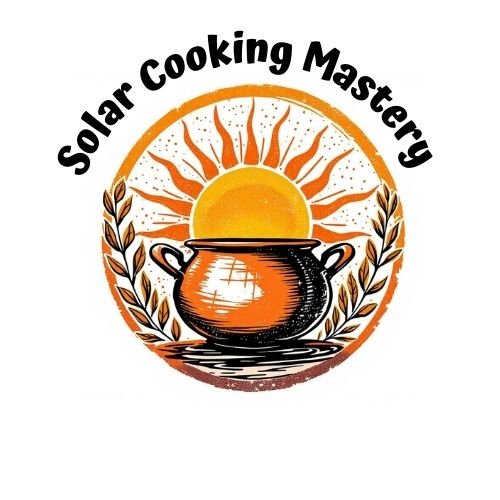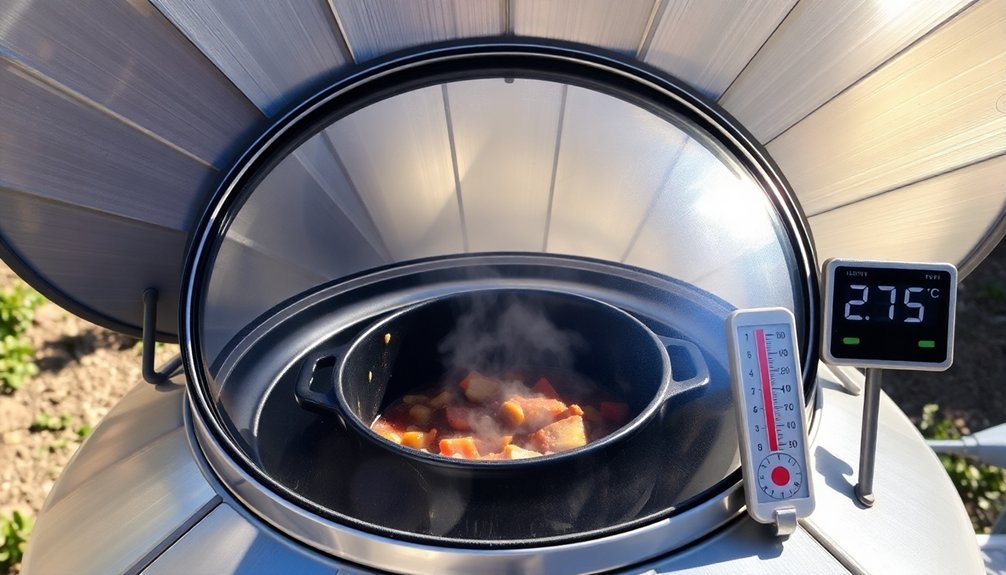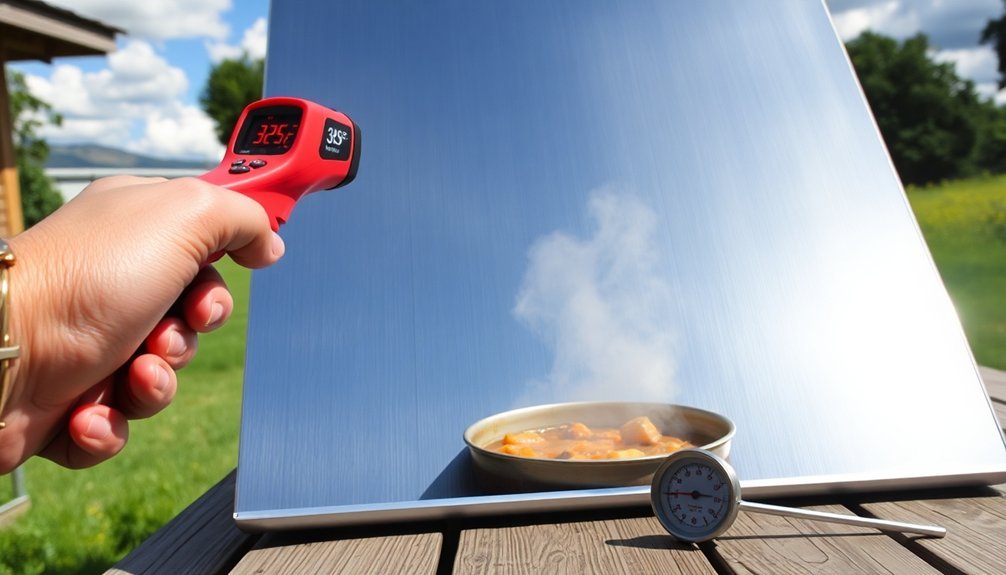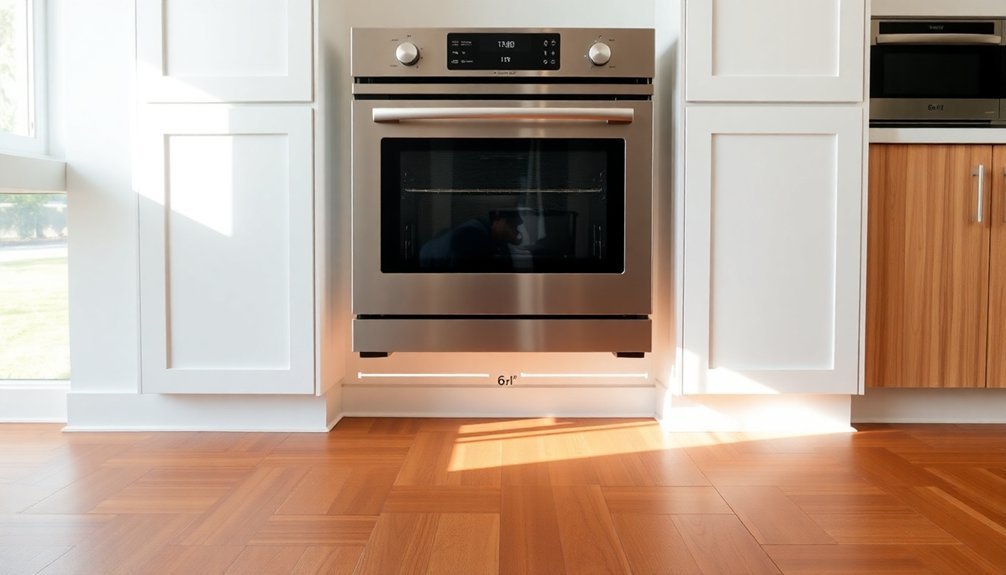Sunlight makes your bean soup taste better because it provides consistent, gentle heat that allows complex flavors to develop naturally. When you cook beans in a solar oven, the steady temperature breaks down tough cell walls more evenly than traditional cooking methods, leading to a creamier texture. The sun's gradual warming process activates aromatic compounds like aldehydes and ketones while preserving essential nutrients and vitamins that harsh heating can destroy. You'll also find that this slow-cooking method helps beans separate naturally at their middle lamella, creating that perfect, tender bite you're looking for. There's much more to discover about the sun's remarkable effect on bean chemistry.
Solar Cooking Bean Basics

A successful solar-cooked bean soup starts with proper preparation and timing. You'll need to pre-soak your beans for at least 4-6 hours or overnight, ensuring they're properly rehydrated before cooking.
Once soaked, drain and rinse them thoroughly, then place them in a dark-colored pot with a lid that will retain heat and steam. The steady temperature in a dark colored pot helps distribute heat evenly during the cooking process.
You'll want to add 1-2 inches of water over your beans and position your solar oven to align with the sun. Throughout the day, you'll need to realign the oven as the sun moves to maintain peak heating efficiency.
The solar oven works like a slow cooker, providing steady, low heat that prevents burning while gradually softening your beans.
Before you begin cooking, preheat your solar oven and consider using the quick-soak method if you're short on time. Add your preferred spices before cooking, and keep an eye on the water level, adding more if needed.
You can cook various types of beans this way, from pinto to lima beans. Remember to use solar-safe materials and plan your cooking schedule according to the sun's path for the best results.
Natural Heat and Bean Chemistry
When you heat your bean soup, whether through solar or traditional cooking, the natural heat breaks down the tough cell walls and complex proteins within each bean.
You'll notice the beans becoming softer as their internal fibers expand and absorb water, while heat-activated enzymes make nutrients more available for your body to absorb. This is especially true for mung bean soups, which are known for their excellent nutritional benefits.
The temperature level matters substantially, as controlled heat triggers the Maillard reaction between proteins and sugars, creating those appealing flavors you taste in perfectly cooked beans.
Bean Structure Changes
Understanding how heat transforms beans requires a look at their complex cellular structure. When you cook beans, you're working with intricate cellular components, including primary and secondary cell walls held together by a cementing agent called the middle lamella. This structure is essential for determining how your beans will turn out when cooked.
As you apply heat to beans, significant changes occur at the ultrastructural level. The cell walls begin to undergo transformation, with the secondary wall losing its reticular structure and developing amorphous matter. Much like soybeans that experience reduced growth when temperatures reach above 86℉, the cellular changes in cooking beans are highly temperature-dependent.
In properly cooked beans, you'll notice the middle lamella breaks down, allowing the cells to separate naturally – this is what gives you that perfect, creamy texture.
However, if your beans have developed the hard-to-cook phenomenon, you'll find the middle lamella resists breaking down, preventing proper cell separation. This is why some beans stay tough even after extended cooking.
When you're cooking beans in sunlight, the natural heat affects the gelatinization process of the starches while simultaneously influencing the cell wall integrity and middle lamella breakdown, contributing to the overall texture and taste of your bean soup.
Heat-Activated Flavor Release
Heat's transformative power on bean chemistry releases a complex symphony of flavors in your soup. When sunlight warms your bean soup, it triggers several key mechanisms that enhance its taste.
The heat activates volatile compounds like aldehydes and ketones, which directly contribute to the aromatic profile you'll experience with each spoonful.
You'll notice improved flavor because heat effectively deactivates certain enzymes like lipoxygenase and peroxidase that can create unwanted taste notes. The warming process also helps control lipid oxidation, which could otherwise lead to off-flavors in your soup. Adding olive or avocado oil during preparation can further enhance the soup's texture while reducing unwanted foam formation.
As the temperature rises, the beans release their natural compounds in a controlled manner, creating a more balanced and enjoyable taste profile.
The heat treatment's effectiveness depends on how you're warming your soup. While conventional cooking methods work well, natural sunlight provides a gentle, gradual heating that can be particularly effective at coaxing out flavors without aggressive protein denaturation.
This slower process allows time for the complex interplay of compounds to develop, much like how different beans respond uniquely to heat – some requiring gentle warming while others benefit from more sustained heat exposure.
Temperature Effects Matter
The precise temperature at which you warm your bean soup plays a central role in releasing its full flavor potential. When you expose your soup to the right temperature, you'll trigger a series of chemical reactions that transform both its taste and texture. The most significant is the Maillard reaction, where proteins and sugars interact to create complex flavors and that appealing golden-brown color. This process becomes even more important during cold and rainy weather conditions, when people naturally crave warming, comforting foods.
You'll notice that temperature control affects your soup's nutrient profile too. Moderate heat increases the bioavailability of minerals while reducing anti-nutrients like phytates and lectins that can interfere with digestion. However, you don't want to overcook it – maintaining a gentle simmer helps preserve those valuable water-soluble vitamins and aromatic compounds that make your soup delicious.
Temperature also influences your soup's texture through multiple mechanisms. As you heat the beans, their cell walls break down and starches begin to swell and gelatinize. This process creates that perfect, creamy consistency you're looking for. But be careful – too much heat can lead to excessive gel formation, turning your soup unnecessarily thick. By maintaining the right temperature, you'll achieve that ideal balance of flavor development and texture.
Maximizing Sunlight for Bean Soups

Despite popular beliefs, exposing your bean soup to sunlight won't enhance its flavor or nutritional value.
You'll find that any perceived improvements in taste are more likely due to psychological factors, such as the pleasant ambiance of natural lighting or cultural associations with sunny weather.
While you can store and serve your bean soup in a naturally lit space for ambiance, the key factors for great taste remain proper cooking techniques, quality ingredients, and appropriate temperature control.
Sunlight Myths and Facts
Many people believe that sunlight magically transforms bean soups into tastier dishes, but scientific evidence tells a different story. While you might think leaving your soup in sunlight will enhance its flavor, this is actually a misconception that needs clearing up.
You'll find that the real keys to a flavorful bean soup lie in your cooking techniques and ingredient choices, not exposure to sunlight. When you're preparing your soup, focus on proven methods like sautéing aromatics, simmering beans properly, and incorporating fresh herbs and spices. These techniques have a direct impact on taste, unlike sunlight exposure.
What you should know is that sunlight can actually be detrimental to your soup's nutritional value. If you expose certain ingredients to direct sunlight, you'll risk degrading important nutrients like Vitamin C.
Instead of relying on sunlight, you'll get better results by properly storing your ingredients and using appropriate cooking methods.
While sunlight can make your soup look more appealing through better lighting for presentation, it won't affect the actual taste. You're better off focusing on quality ingredients, proper seasoning, and tried-and-true cooking techniques to create a delicious bean soup.
Natural Light Storage Tips
Properly storing your bean soup ingredients requires careful attention to light exposure, despite common misconceptions about sunlight's benefits. You'll need to protect your dried beans and legumes from direct light by keeping them in dark, sealed containers to maintain their flavor and nutritional value.
When storing aromatics for your soup, like onions and garlic, place them in ventilated containers away from sunlight. Use mesh bags or terracotta pots in a cool, dark space to prevent sprouting and maintain their robust flavors.
Your spices, which are essential for bean soup seasoning, should be stored in steel tins inside a dark cabinet to preserve their potency.
While your kitchen design might feature south-facing windows and reflective surfaces to maximize natural light, you'll want to create dedicated dark storage areas for your ingredients. Consider installing cabinet organizers or using drawer systems that protect light-sensitive items.
If you're working with limited space, you can use opaque containers or add light-blocking liners to existing storage areas. Remember that while natural light is excellent for food photography and kitchen ambiance, it's often detrimental to ingredient preservation.
Traditional Solar Bean Cooking Methods
Traditional solar bean cooking relies on a methodical preparation process that begins with overnight soaking. You'll need to rinse your pre-soaked beans before cooking to remove excess phosphates, which guarantees more even cooking and better rehydration of the dried beans.
When you're ready to cook, select a dark-colored pot with a cover for ideal heat retention. Cover your beans with 1 to 2 inches of water, and add your preferred spices before placing the pot in your solar oven.
You'll need to adjust the oven's position throughout the day to maximize sun exposure, similar to how you'd use a crockpot.
The cooking process takes several hours, as solar ovens work by gradually building and retaining heat and steam. You won't need to worry about burning your beans, as the heat distribution remains even throughout the cooking process.
Remember that cooking times can vary based on your altitude and the type of beans you're using. Starting early in the day guarantees your beans will be ready when you need them.
For the best results, check your solar oven regularly and reposition it to maintain prime sunlight exposure.
Timing Your Solar Bean Preparation

Successful solar bean cooking hinges on precise timing and preparation. You'll need to start by soaking your beans overnight, which substantially cuts down the cooking time from 2-4 hours in your solar oven. Using dark-colored pots with covers helps retain heat and steam throughout the process.
| Time of Day | Essential Actions |
|---|---|
| Previous Night | Soak beans in water |
| Early Morning | Position solar oven, add beans |
| Mid-Day | Adjust oven alignment |
| Late Afternoon | Check bean tenderness |
For the best results, you'll want to begin cooking early in the day to maximize sunlight exposure. Your solar oven works like a slow cooker, allowing beans to simmer steadily while developing rich flavors. Remember to periodically adjust the oven's position to follow the sun's path across the sky.
If you're short on time, consider using pre-cooked, dehydrated beans as an alternative. You can even cook multiple types of beans simultaneously by using separate quart jars in your solar oven. The longer your beans simmer in the solar oven, the softer and more flavorful they'll become, making timing vital for achieving your desired consistency.
Best Beans for Solar Cooking
When selecting beans for solar cooking, certain varieties prove more reliable than others. Pinto beans are your best bet, as they respond exceptionally well to the slow, even heating of a solar oven. You'll also find success with lima beans, and if you're looking to experiment, a 15-bean mix can work well too.
You'll want to focus on dried beans rather than canned varieties, as they benefit most from solar cooking's gradual heating process. If you're short on time, consider using quick-cook dehydrated pinto beans, which will reduce your cooking duration while still delivering great results.
If you're cooking at high altitude, you'll need to plan accordingly. Start your bean preparation earlier in the day and keep your solar oven well-focused on the sun, as cooking times increase with elevation. You'll be amazed to know that solar ovens work effectively even at Mount Everest base camps.
The slow, consistent heat of your solar oven will tenderize your beans perfectly while preserving their nutrients and flavors. You won't need to worry about burning them, and you can leave them unattended while they cook – a significant advantage over traditional stovetop methods.
Frequently Asked Questions
Does Sunlight Affect the Nutritional Content of Beans While Cooking?
No, sunlight doesn't affect your beans' nutritional content while cooking. Your beans' nutrients are primarily affected by cooking method, heat, and water – not by exposure to sunlight during the cooking process.
Can Moonlight Have Similar Effects on Bean Soup Taste?
You won't find scientific evidence that moonlight affects bean soup's taste. While some follow biodynamic beliefs about lunar cycles and food, any perceived differences are likely due to personal expectations rather than actual effects.
Do Different Colored Containers Impact How Sunlight Enhances Bean Soup Flavor?
Yes, your container's color will affect how sunlight enhances bean soup flavor. You'll notice stronger effects with red or yellow containers, which amplify warmth perception, while blue or green containers create subtler enhancements.
Will Cloudy Days Completely Eliminate the Sunlight's Effect on Beans?
You'll still get some sunlight's effects even on cloudy days, though they're diminished. Clouds filter but don't completely block UV rays, so you'll notice a milder enhancement to your bean soup's flavor.
How Does Altitude Affect Sunlight's Interaction With Cooking Beans?
You'll find that higher altitudes actually enhance sunlight's effects on beans since there's less atmosphere to filter UV rays. This can intensify the photochemical reactions while your beans are cooking outdoors.
In Summary
You've discovered that sunlight's gentle, consistent heat allows beans to slowly develop their complex flavors while breaking down tough fibers more effectively than rapid cooking. When you're solar cooking beans, you'll get better results because the gradual temperature rise lets starches convert naturally and helps retain nutrients. Next time you make bean soup, try positioning your pot to catch maximum sunlight – you'll taste the difference!





Leave a Reply